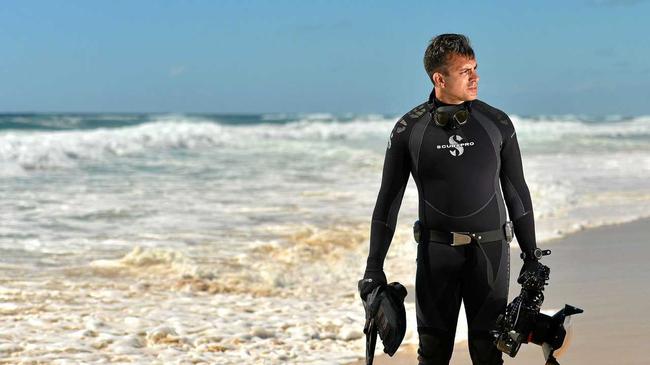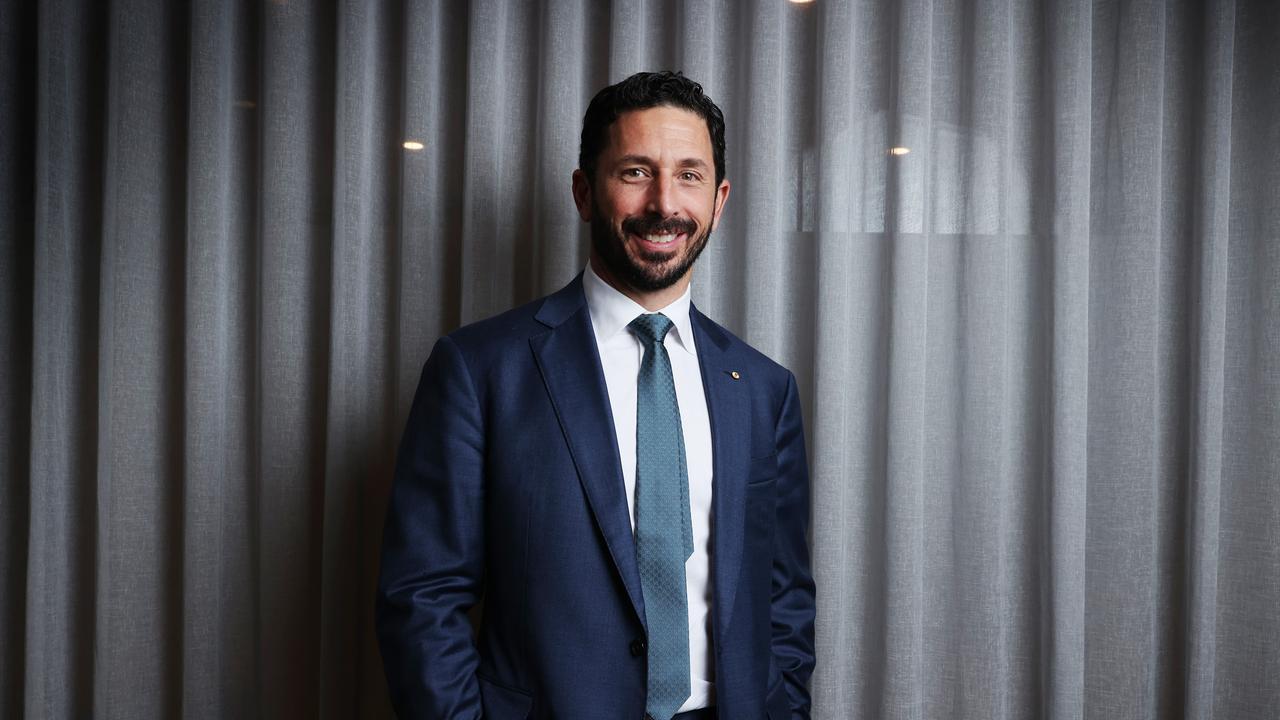Taking creative business into the dangerous deep
He brings the mysteries of the underwater world to the living rooms and hotel lobbies of everyday people.

Business
Don't miss out on the headlines from Business. Followed categories will be added to My News.
Have you ever swum face to face with a sea turtle? Have you ever played in the depths of the ocean with a humpback whale calf? Or spent hours hanging out with Nemo at his home on the coral reef?
Justin Bruhn has, and it's all just part of his "day job".
When he first founded his Noosa-based business Pure Underwater Imaging, he had an empowering vision to connect people with the ocean. He wanted individuals to fall in love with it, in the hope that it would inspire them to better care for it.
"I want people to see how beautiful our marine life is. Like Jacques Cousteau once said, 'We protect what we love' and if I can evoke that emotional response, we create more of a connection with people and our marine life. Hopefully, that will stick in people's minds and motivate them to pick up that piece of plastic they see at the beach or not use that straw at a bar," Justin said.
Justin's work brings the mysteries of the underwater world to the living rooms and hotel lobbies of everyday people, reminding them that the wonder of the ocean is something worth protecting.
His passion for marine conservation spans an impressive career, from his first scuba dive in South Australia back in 1993 to his worldwide travels working as a dive instructor and photographer.
Starting out in Thailand with just 30 dives under his belt, Justin was eager to find a way to turn his hobby into a career.
Before long, he began his Dive Master course, the first of his professional training at a little island called Koh Tao in the Gulf of Thailand.
Travelling across the globe spawned a love of landscape photography in Justin, and the self-taught creative began investing in his own equipment.
When he finally returned to Australia, he scored a job working in what he calls "the most magnificent place on Earth": the Great Barrier Reef.
"Working on the Great Barrier Reef, I remember being overwhelmed with feelings of gratitude for just being there, and having the opportunity to work in that environment," Justin said.
The social aspect of working with new people every day, combined with an endless amount of time spent in the water, made dive instructing a dream job for Justin.
But after living in North Queensland for some time, he felt an unexplainable desire to reawaken his creative side.
So he submerged his lens underwater and began exploring photography from a new perspective.
"I was taking shots of people with Nemo and with giant potato cod down at the Cod Hole. I got to go to some amazing places on the Great Barrier Reef like Osprey Reef and document the shark feeds out there. From there, I decided that my passion was underwater photography, and luckily I was good at it," Justin said.
"I love the challenge of underwater photography. Things are moving a lot faster so you really have to be aware.
"It's about understanding your environment because there are a lot of dangers in the underwater world, like currents and obviously running on an air supply as well as the marine creatures themselves."
In the 26 years he's worked in the ocean, Justin has witnessed the deterioration of the Great Barrier Reef, episodes of coral bleaching, the decline of species and endless amounts of unethical fishery activity.
In his eyes, these are all tragedies, but Justin wants to fight the battle to help reverse their adverse effects.
This is why he partners with organisations such as Sea Shepherd and the Australian Marine Conservation Society (AMCS).
"It's very confronting to see what's going on around the world in terms of shark finning, the rate sharks are getting killed, whaling and the industry that's supporting the killing of manta rays, for example," Justin said.
According to statistics revealed by One Green Planet, the shark-finning industry has decreased the entire shark population by 60 to 90 per cent over the past 15 years.
In previous years, the AMCS placed immense pressure on the Australian Government to act against the shark-finning industry. The campaign prompted a formal response from the (then) assistant minister for agriculture and water resources Anne Ruston and the action became illegal across all Commonwealth jurisdictions.
"That's how we can make a difference, by lobbying against large corporations and appealing to our politicians to stop decisions and developments going ahead that are going to be destructive to the environment," Justin said.
"I've got a lot of respect for what Sea Shepherd do. The hard work that they do out in the oceans, the hands-on stuff - we need that.
"But we also need people on the books hitting corporations at the top."
Not only does Justin's art draw an emotional connection between people and the ocean, but it also has a tangible effect in this fight to save the seas.
A portion of sales from each piece at Pure Underwater Imaging is donated directly to the AMCS, to help spread its important message of conservation further.
"The more people who become aware of the problems, then the more people who are going to take action and be part of the solution," Justin said.
One of Justin's favourite pieces, Solitude, is the next piece of the puzzle in this environmental journey.
The exquisite shot is an aerial view of a manta ray gliding above shallow reefs, taken at Lady Elliot Island.
The manta ray is the ocean's largest glider, with a wingspan of up to seven metres. It's a sea creature that has the ability to absolutely mesmerise.
But the animal is under attack: overfished for its gills and sold to an industry worth $5- 10 million each year. Despite the fact the animal contributes $100 million a year to nearby tourism industries, overfishing is still the biggest threat to the species.
Statistics released by Wild Aid indicate the manta ray population has decreased from 58 to 88 per cent over the past few years - a decline that is unsustainable for an animal that can take up to 10 years to sexually mature.
The AMCS is in the middle of a campaign against manta ray fishing, and to aid this battle, Justin is donating the entire proceeds from the sale of Solitude back to the conservation organisation.
This is a gesture he believes is just a part of his integral duty'.
"We can't be complacent. We can't have the attitude that someone else is going to fix it. We need to do what we can and we need to do it now," Justin said.
"On a smaller scale, people can be mindful in their choices at the supermarket and use tools such as the Sustainable Seafood Guide on the AMCS website."
On January 3, Justin opened a pop-up gallery for Pure Underwater Imaging inside the Pavilion at Noosa Junction.
His gallery and works will be on display for the whole school-holiday period.
To find out more about Pure Underwater Imaging, visit pureunderwaterimaging.com/
or call 0411 050 133


